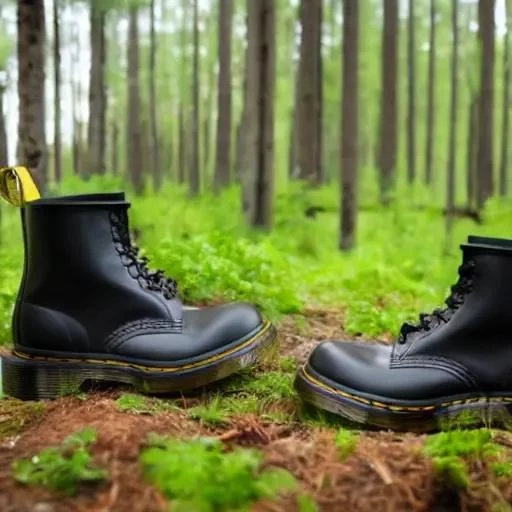
Today is 10/04/2025 06:15:20 ()
For decades, Dr. Martens boots have transcended mere footwear, evolving into powerful symbols of rebellion, counter-culture, and enduring style. Affectionately known as “Docs,” these robust leather boots, with their distinctive yellow stitching and air-cushioned soles, have graced stages, city streets, and countless personal narratives, becoming synonymous with durability and a certain urban edge. Yet, a fascinating question frequently emerges from the outdoor community: can these beloved, famously tough boots truly conquer the rugged demands of the hiking trail, or are they destined to remain an urban legend in the wilderness?
The allure of taking a pair of Docs onto a mountain path is undeniably strong for many; their legendary toughness and enduring comfort, once broken in, promise a steadfast companion. However, the traditional perception of Dr. Martens as dedicated hiking gear has been, at best, ambiguous. Avid trekkers often prioritize specialized features like lightweight construction, advanced waterproofing, and superior ankle support – characteristics not typically associated with the classic 1460 boot. This article delves into the evolving landscape of outdoor footwear, exploring whether Dr. Martens has truly stepped up to meet the demands of the modern hiker, challenging long-held assumptions and revealing a nuanced truth about these iconic boots.
| Category | Detail |
|---|---|
| Brand Overview | Dr. Martens is a British footwear brand, founded in 1947, renowned globally for its durable, comfortable, and stylish leather boots and shoes. Its iconic designs feature air-cushioned soles, yellow stitching, and a distinctive silhouette. |
| Primary Purpose | Originally developed as robust work boots, Dr. Martens gained immense popularity as a fashion statement, becoming a staple in various subcultures and an emblem of personal style and durability. |
| General Hiking Suitability | While incredibly durable, traditional Dr. Martens models are generally not considered optimal for serious, long-distance, or technical hiking. Their weight, stiffness, and lack of specialized features (like advanced waterproofing or superior ankle support) can be limiting on tough terrain. |
| Suitability for Casual/Light Hiking | For casual walks, urban exploration, or lighter trails in moderate conditions, certain Dr. Martens styles can perform adequately, especially once properly broken in. Their inherent toughness offers protection and longevity. |
| Recommended Dr. Martens Styles for Hiking |
|
| Key Benefits (When Used for Hiking) | Exceptional durability, long-lasting real leather construction, unique style, comfort after break-in, and good grip on certain lug-soled models. |
| Key Concerns (When Used for Hiking) | Significant weight, initial stiffness requiring a long break-in period, limited waterproofing on standard models, potentially inadequate ankle support for uneven terrain, and less cushioning compared to dedicated hiking boots. |
| Official Website | www.drmartens.com |
Historically, the conventional wisdom has been unequivocal: Doc Martens, while incredibly tough, are not the optimal choice for arduous hikes. Experts and seasoned trekkers have often pointed to their considerable weight, inherent stiffness, and often questionable ankle protection as significant drawbacks. As one outdoor enthusiast noted in July 2024, their “tendency to rub” and “lack of waterproofing” on many classic models can quickly turn a scenic trek into an uncomfortable ordeal. For serious expeditions on challenging terrain, where every ounce matters and reliable support is paramount, a dedicated hiking boot, engineered with advanced materials and ergonomic design, remains undeniably superior.
However, the narrative isn’t entirely one-sided. Dr. Martens, a brand keenly aware of evolving consumer desires, has been quietly innovating, introducing styles that subtly bridge the gap between street fashion and outdoor utility. Consider models like the 939 Ben Boot, boasting a more robust lug sole and enhanced padding around the heel. These nuanced adaptations represent a significant departure from the traditional silhouette, offering improved grip and comfort for those venturing beyond city pavements. Furthermore, some users, surprisingly, have reported successful casual hiking experiences with lighter, more flexible options such as the Combs Tech, praising its performance on less demanding trails.
The debate isn’t about whether a Doc Martens boot can survive a hike—their famed durability ensures that. Instead, it revolves around the quality of the hiking experience. For casual strolls through nature parks, urban exploration, or even moderate trails in dry conditions, a well-broken-in pair of Docs, particularly those with a commando-style sole for extra grip, can be surprisingly capable. One user proudly recounted wearing waterproof Doc Martens for “long enough routes” in Ireland, experiencing no issues. This personal testimony highlights a critical distinction: the context of the hike. A leisurely day trip fundamentally differs from a multi-day backpacking adventure requiring peak performance footwear;
The brand itself has acknowledged this growing interest, proactively offering “Hiker Style Boots” that incorporate features like padded collars and more aggressive sole units, directly addressing some of the traditional criticisms. By integrating insights from evolving outdoor trends and listening to their diverse customer base, Dr. Martens is subtly reshaping its identity, proving that iconic style and practical function are not mutually exclusive. While they may never replace a highly specialized mountaineering boot, these updated offerings demonstrate a forward-looking commitment to versatility, inviting a broader audience to experience the famed Doc Martens comfort and resilience in new, adventurous ways.
Ultimately, the question of whether Doc Martens make “good hiking boots” demands a nuanced answer, dependent entirely on the specific demands of your adventure. For those prioritizing enduring style, unparalleled durability, and comfort on lighter trails, certain Dr. Martens models offer a compelling, albeit unconventional, choice. However, for the serious trekker tackling rugged landscapes and unpredictable weather, dedicated hiking footwear remains the gold standard. As Dr. Martens continues to evolve, pushing the boundaries of what its iconic boots can achieve, it’s clear that the future holds exciting possibilities for a brand already celebrated for standing the test of time, both on the street and, increasingly, on the trail. The journey ahead for Doc Martens in the outdoor world is just beginning, promising a captivating blend of heritage and innovation.
